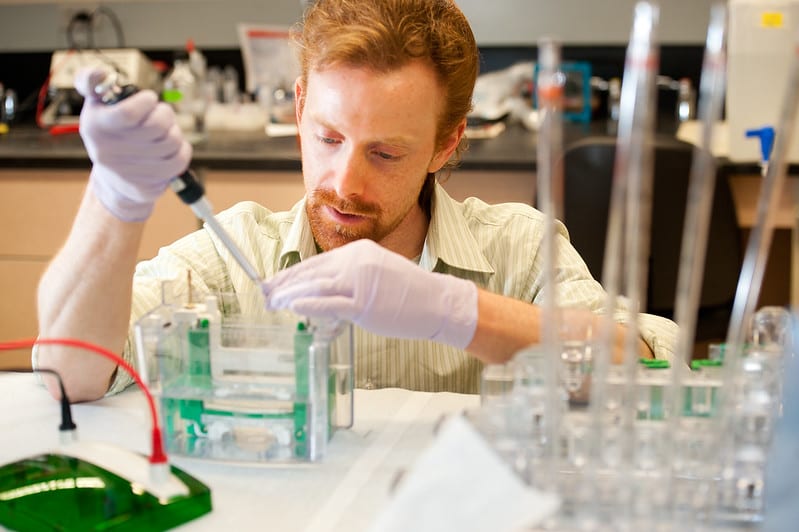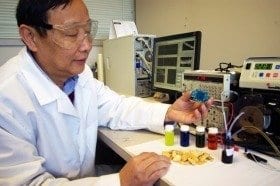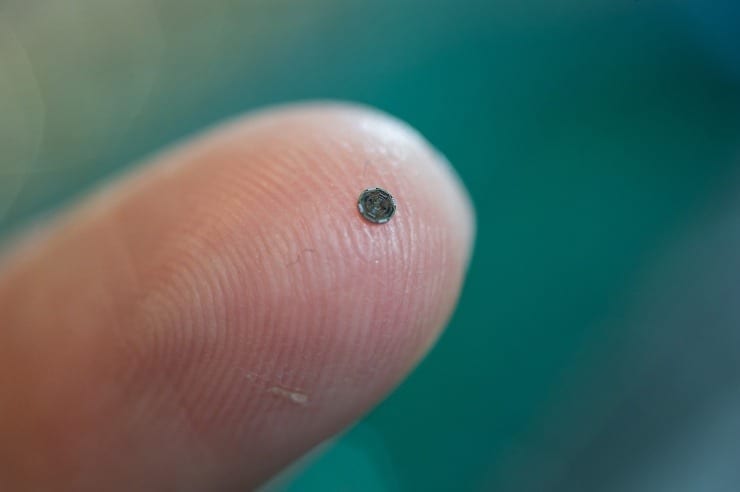
Duke researchers use gene therapy to direct stem cells into becoming new cartilage on a synthetic scaffold even after implantation into a living body
By combining a synthetic scaffolding material with gene delivery techniques, researchers at Duke University are getting closer to being able to generate replacement cartilage where it’s needed in the body.
Performing tissue repair with stem cells typically requires applying copious amounts of growth factor proteins—a task that is very expensive and becomes challenging once the developing material is implanted within a body. In a new study, however, Duke researchers found a way around this limitation by genetically altering the stem cells to make the necessary growth factors all on their own.
They incorporated viruses used to deliver gene therapy to the stem cells into a synthetic material that serves as a template for tissue growth. The resulting material is like a computer; the scaffold provides the hardware and the virus provides the software that programs the stem cells to produce the desired tissue.
The study appears online the week of Feb. 17 in the Proceedings of the National Academy of Sciences.
Farshid Guilak, director of orthopaedic research at Duke University Medical Center, has spent years developing biodegradable synthetic scaffolding that mimics the mechanical properties of cartilage. One challenge he and all biomedical researchers face is getting stem cells to form cartilage within and around the scaffolding, especially after it is implanted into a living being.
The traditional approach has been to introduce growth factor proteins, which signal the stem cells to differentiate into cartilage. Once the process is under way, the growing cartilage can be implanted where needed.
“But a major limitation in engineering tissue replacements has been the difficulty in delivering growth factors to the stem cells once they are implanted in the body,” said Guilak, who is also a professor in Duke’s Department of Biomedical Engineering. “There’s a limited amount of growth factor that you can put into the scaffolding, and once it’s released, it’s all gone. We need a method for long-term delivery of growth factors, and that’s where the gene therapy comes in.”
The Latest on: Replacement Tissue
[google_news title=”” keyword=”Replacement Tissue” num_posts=”10″ blurb_length=”0″ show_thumb=”left”]
via Google News
The Latest on: Replacement Tissue
- Diabetes In Women: Study Suggests Link Between High Blood Sugar and Frozen Shoulder in Womenon April 27, 2024 at 9:31 pm
Diabetes affects women just like men, but there can be some added considerations. Read on to know how it affects shoulder health as you grow older.
- 193 kg US man undergoes total knee replacement at Jaslok Hospitalon April 27, 2024 at 9:00 pm
Mumbai: Jaslok Hospital achieves a remarkable milestone in the field of orthopaedic surgery with the successful Total Knee Replacement (TKR) procedure on a 193 kg patient, marking a ...
- The best protein supplements of 2024 – but do they work?on April 27, 2024 at 5:00 am
Protein supplements are not only for young men looking to bulk up in the gym. Emerging research suggests that they may hold benefits for midlifers and older adults, as our protein requirements ...
- Blood test finds knee osteoarthritis up to 8 years before it appears on X-rayson April 26, 2024 at 11:00 am
Detecting knee osteoarthritis with a blood test up to eight years before it appears on X-rays -- as researchers have done -- could lead to therapies that delay disease progression and restore joint ...
- Strategies for Successful MedTech Startups: Insights from an Experienced Innovator Strategies for Successful MedTech Startups: Insights from an Experienced Innovatoron April 26, 2024 at 10:36 am
Dr. Maria Putilina, a seasoned medical advisor and innovator, offers valuable insights into the transition from innovation consulting to startup entrepreneurship, shedding light on common pitfalls ...
- Is Natural Hormone Replacement Therapy Better?on April 25, 2024 at 2:11 pm
Natural hormone replacement therapy (NHRT) is considered an alternative approach to conventional hormone replacement therapy (HRT). It may use natural or " bioidentical " treatments to restore ...
- 8 bad habits that make you age faster, according to expertson April 24, 2024 at 2:30 am
Some factors associated with aging can be controlled. Doctors shared with Fox News Digital the eight most common unhealthy behaviors that speed up the aging process — and how to avoid them.
- Balancing hope and reality: The promise and peril of blood-based colorectal cancer screeningon April 24, 2024 at 1:30 am
A simple blood test to detect colorectal cancer sounds amazing. But unlike colonoscopy, a blood test can't remove precancerous polyps.
- Medtronic launches next-gen surgical aortic tissue valveon April 22, 2024 at 12:09 pm
Medtronic (NYSE: MDT) today announced the launch of its next-generation Avalus Ultra surgical aortic tissue valve.
- Exactech Strengthens Position as Soft Tissue Balancing Technology Leader with New Patentson April 22, 2024 at 6:00 am
Exactech, a developer and producer of innovative implants, instrumentation and smart technologies for joint replacement surgery, announced today that the U.S. Patent and Trademark Office (USPTO) has ...
via Bing News










